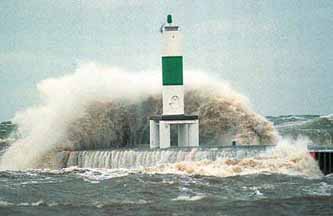 |

Fall Storms Create Challenges for Tieing Up Boats
I’m tied up at work…
When I was a kid, and my Dad (Herb) was late for dinner, he would
say, “I’m tied up at work.” My five-year-old mind pictured
him backed up against a piling with huge 3-strand lines wrapped around
him securing him to the piling. I guess that’s what happens when
one grows up at a boatyard.
Growing up at the boatyard also means that when there is a storm, it is a family event going out and walking the docks to make sure everyone’s boat is tied up and safe. With strong 50-knot wind gusts at the marina during the fall, boats are sometimes found resting on pilings and also uncomfortably close to hitting. The majority of boats weather the storm fine, but in all, about 20 percent of boats are usually retied and secured.
A few observations to help you secure your boat:
• For convenience, many boats are tied up close to the dock for easy and safe passenger access. In the wind, these boats were hitting the docks. After Labor Day, position the boat in the center of the slip. There should be 15”-18” of space between the hull and the dock. Is your slip big enough?
• If a line is frayed, worn, or damaged you need to replace it. A damaged dock-line will break. Many lines were either damaged or too small of a diameter to be effective. These lines were the first to break.
• Many boats did not have extra lines on board. It is a quick fix when spare lines are readily accessible from your boat. Keep several, good quality dock lines aboard in an easily accessible location. Labeling the location would also help.
• When in doubt, use two lines instead of one! The worst winds are from the northwest and consequently the lines leading from your boat to the northwest are the most critical.
• Check your boat, day or night, to assess your situation. I saw many owners here making sure their boats were secure. This appeared to be the best way to prevent damage.
• If you are new, ask a slip neighbor for suggestions.
• Expect the worst! While you are here, you can monitor the conditions, but when you leave, you should prepare for a storm.
• Lines and power chords should not be intertwined with each other around the same piling. A power chord should have several feet of slack in it. If the chord is tight, the dock lines will stretch and you will end up damaging your powr chord or power hook up.
• Boats on Shorestations and lifts should be raised
out of the water so that they are not affected by waves and higher water
levels.